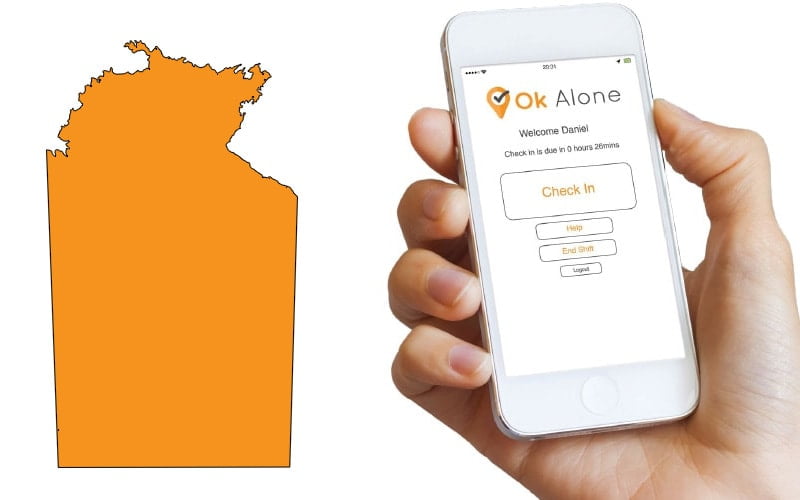Here are the acts and regulations found in the Northern Territories, related to lone working and work alone employees. We cover all the lone worker policy and legislation we have found for this area, specifically for the Northern Territories.
WORK HEALTH AND SAFETY (NATIONAL UNIFORM LEGISLATION) ACT 2011
Division 2 – Primary duty of care
19 – Primary duty of care
(1) A person conducting a business or undertaking must ensure, so far as is reasonably practicable, the health and safety of:
(a) workers engaged, or caused to be engaged, by the person; and
(b) workers whose activities in carrying out work are influenced or directed by the person; while the workers are at work in the business or undertaking.
(2) A person conducting a business or undertaking must ensure, so far as is reasonably practicable, that the health and safety of other persons is not put at risk from work carried out as part of the conduct of the business or undertaking.
(3) Without limiting subsections (1) and (2), a person conducting a business or undertaking must ensure, so far as is reasonably practicable:
(a) the provision and maintenance of a work environment without risks to health and safety; and
(b) the provision and maintenance of safe plant and structures; and
(c) the provision and maintenance of safe systems of work; and
(d) the safe use, handling and storage of plant, structures and substances; and
(e) the provision of adequate facilities for the welfare at work of workers in carrying out work for the business or undertaking, including ensuring access to those facilities; and
(f) the provision of any information, training, instruction or supervision that is necessary to protect all persons from risks to their health and safety arising from work carried out as part of the conduct of the business or undertaking; and
(g) that the health of workers and the conditions at the workplace are monitored for the purpose of preventing illness or injury of workers arising from the conduct of the business or undertaking.
WORK HEALTH AND SAFETY (NATIONAL UNIFORM LEGISLATION) REGULATIONS 2011
Division 2 – General working environment
40 – Duty in relation to general workplace facilities
A person conducting a business or undertaking at a workplace must ensure, so far as is reasonably practicable, the following:
(a) the layout of the workplace allows, and the workplace is maintained so as to allow, for persons to enter and exit and to move about without risk to health and safety, both under normal working conditions and in an emergency;
(b) work areas have space for work to be carried out without risk to health and safety;
(c) floors and other surfaces are designed, installed and maintained to allow work to be carried out without risk to health and safety;
(d) lighting enables:
(i) each worker to carry out work without risk to health and safety; and
(ii) persons to move within the workplace without risk to health and safety; and
(iii) safe evacuation in an emergency;
(e) ventilation enables workers to carry out work without risk to health and safety;
(f) workers carrying out work in extremes of heat or cold are able to carry out work without risk to health and safety;
(g) work in relation to or near essential services does not give rise to a risk to the health and safety of persons at the workplace.
Maximum penalty:
(a) in the case of an individual – $6 000.
(b) in the case of a body corporate – $30,000.
The comprehensive 34-page document from WorkSafe outlines the importance of the work environment, remote communications systems and procedures, risk prevention, emergency plans, vehicles, travel and much more.
The guide asks, ‘Who is considered a ‘lone worker’? Lone workers are considered those who work by themselves and/or work in the community with only limited support arrangements, which therefore expose them to risk by being isolated from the usual back-up support.
What if it is only once? This is the case whether they regularly work alone or are only occasionally alone and do not have access to immediate support from managers or other colleagues. The guide does not set down a minimum time that a worker has to be on their own for them to be considered ‘remote’ or ‘isolated’. Each situation should be assessed according to its circumstances, taking into account specific factors that may present a risk to the worker.
What should I be aware of as an employer? Although the terms ‘remote’ and ‘isolated’ fall under the same definition there are some key differences that PCBUs*, safety practitioners, managers, supervisors and workers should be aware of:
▪ Isolated work may involve work activities undertaken in an isolated area (geographical isolation), on or off site, either during or outside normal working hours (temporal isolation).
▪ Remote work may involve work activities undertaken at a location removed from an office environment where there are few people and where communications and travel are difficult. This may include land or sea activities within Australia or overseas. A worker may be considered remote or isolated even if other people may be close by. In some situations, a worker may be alone for a short period of time, while in other situations they may be on their own for days or weeks in a remote location. Workers may work remotely or in isolation if they:
▪ physically work alone, for example, at night in a laboratory
▪ work separately from others, for example, in a regional office building, work at home or engage in teleworking activities
▪ work outside normal working hours, for example, on call workers
▪ work shift work or night work, travel as part of work, travel long distances, for example, freight transport drivers
▪ work unsupervised, for example, teleworkers
▪ work in geographical isolation, for example, scientists or park rangers carrying out field work
▪ work on a reduced roster, for example, on public holidays
▪ work in isolation with members of the public, for example, health and community workers.
*a person/entity conducting a business or undertaking

As an expert in lone worker content management, I possess an extensive knowledge base and experience in the area of lone working and safety monitoring. My expertise in this field encompasses a wide range of areas, including risk assessment, training, communication, and technology. I have a deep understanding of the unique risks associated with lone workers and have researched and written many projects and articles to educate people in how to mitigate these risks.
Throughout my time with Ok Alone, I have kept up to date with technological developments, legislative changes and regulations that have been introduced to help organizations ensure the safety of their lone workers.

